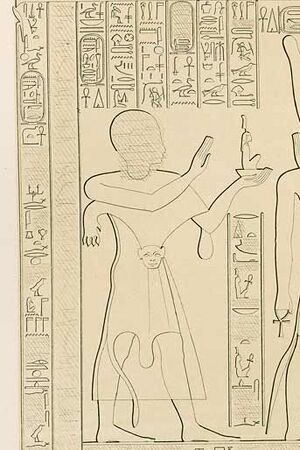Osorkon III facts for kids
Quick facts for kids Osorkon III |
|
|---|---|
| Pharaoh | |
| Reign | 28 years (23rd Dynasty) |
| Predecessor | Shoshenq VI |
| Successor | Takelot III |
| Consort | Karoadjet, Tentsai |
| Children | Shepenupet I, Takelot III, Rudamun |
| Father | Takelot II |
| Mother | Karomama II |
Osorkon III was an ancient Pharaoh of Egypt who ruled in the 8th Century BC. His full royal name was Usermaatre Setepenamun Osorkon Si-Ese Meryamun, Netjer-Heqa-waset.
He was also known as Crown Prince Osorkon B. He served as the High Priest of Amun in the important city of Thebes. His father was Takelot II, and his mother was Karomama II.
Prince Osorkon B is famous for his Chronicle. This is a collection of texts that describe his actions in Thebes. These texts can be found on the Bubastite Portal at Karnak.
Osorkon III became king in Upper Egypt after winning against the forces of Pedubast I and Shoshenq VI. These rivals had challenged his father's power. Osorkon III ruled for 28 years. For the last five years, he ruled alongside his son, Takelot III. This shared rule is called a coregency.
When Did Osorkon III Become Pharaoh?
We don't know the exact date Osorkon III became pharaoh. Experts think it was sometime between 790 BC and 787 BC.
It's a bit tricky because Prince Osorkon B didn't immediately declare himself king. He waited after he took control of Thebes and defeated Shoshenq VI. Instead, he dated this important event to the 39th year of Shoshenq III's reign.
Osorkon III might have waited a year or two before calling himself pharaoh. He probably wanted to make sure all his rivals were defeated. This included supporters of Pedubast I and Shoshenq VI in other parts of Upper Egypt. So, his first year as pharaoh might have been the same as Year 1 or 2 of Shoshenq IV.
Who Was Osorkon III?
Many stone carvings and blocks from places like Herakleopolis Magna and Thebes mention Osorkon III. He is believed to have lived at the same time as the Lower Egyptian kings of the 22nd Dynasty. These kings included Shoshenq IV, Pami, and the early years of Shoshenq V.
Osorkon III's main wife was Queen Karoadjet. His second wife was named Tentsai. A stone carving from Prince Osorkon B mentions his wife as Tent[...]. This name could be Tentsai or Tentamun. What's important is that both Osorkon III and Prince Osorkon B had a daughter named Shepenupet.
In 1982, an important stone carving was found at Akoris. This carving showed that Osorkon III was once a High Priest of Amun. This strongly suggests that Osorkon III and Prince Osorkon B were the same person. Prince Osorkon B was the one who defeated his father's enemies in Thebes.
Many Egyptologists now agree with this idea. This includes experts like Jürgen von Beckerath and Aidan Dodson. They point out that Osorkon B's last appearance as High Priest of Amun happened just before Osorkon III became king. The carving from Akoris also calls Osorkon III a High Priest, which was unusual for a king.
Osorkon III likely lived to be around 80 years old. This is probably why he made his son, Takelot III, a junior co-ruler in his final years. He would have been quite old and perhaps not in good health. This shared rule between Osorkon III and Takelot III was the last one recorded in ancient Egyptian history. Later dynasties had only one king ruling at a time.
Records from Karnak, called Nile Level Texts No. 6 and 7, mention Osorkon III's mother. They call her "Chief Queen Kamama Merymut." Prince Osorkon B's mother was also Queen Karomama Merymut II, wife of Takelot II. These slightly different names almost certainly refer to the same person.
Osorkon III's Family
According to Kenneth Kitchen, Osorkon III's main wife, Queen Karoadjet, was the mother of Shepenupet I. Shepenupet I held the important religious titles of God's Wife and Divine Adoratrice of Amun.
His second wife, Tentsai, was the mother of Osorkon III's two sons: Takelot III and Rudamun. Shepenupet I lived longer than both of her half-brothers. She continued to serve as the God's Wife of Amun in Thebes. She was still in this role during the reign of the Nubian ruler, Shebitku. She is shown in a small temple at Karnak that was partly decorated by Shebitku.


